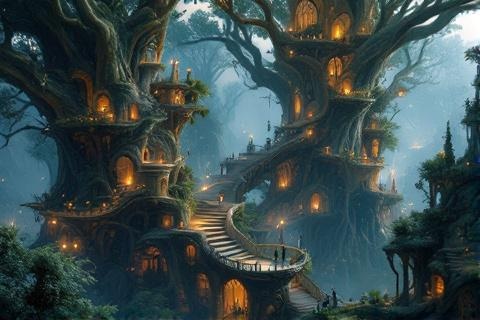
Lothlórien: The Enchanted Realm of the Golden Wood
Secrets, Legends, and the Timeless Magic of Tolkien's Elven Sanctuary
The Golden Wood: Geography and Natural Splendor

Lothlórien stands majestically at the meeting point of two great rivers of
Middle-earth: the Silverlode (Celebrant) and the mighty Anduin. This strategic
location made it a natural fortress, with the rivers serving both as
transportation routes for the elves and as protective boundaries
against enemies. The confluence created a wedge-shaped region known as the Naith
of Lórien, with the heart of the realm, Caras Galadhon, located within this
protected area.
The most striking feature of Lothlórien is its legendary mallorn trees, which
grow nowhere else in Middle-earth except for one specimen
in the Shire. These massive trees reach heights that dwarf
ordinary forests, with smooth grey bark that shimmers like silver and leaves
that turn golden in autumn but never fall. Throughout winter, the golden canopy
remains, creating an eternal autumn appearance that gave rise to the name
'Golden Wood.'
The realm's natural defenses include not only the rivers but also the
surrounding hills and valleys. The northern border is protected by steep
highlands, while the southern edge meets the Misty Mountains' foothills. These
geographical features, combined with the dense forest itself, create multiple
layers of defense that have helped preserve Lothlórien through ages of conflict
in Middle-earth.
Within Lothlórien's borders, the power of the elves maintains a unique
microclimate where time seems to flow differently. While the outside world
experiences harsh winters and changing seasons, the Golden Wood remains in a
perpetual state of enchanted autumn. This magical preservation comes from the
power of Galadriel's ring, Nenya, which maintains the
realm in an unchanging state of beauty and warmth.
Caras Galadhon: The Heart of Elvendom

Caras Galadhon, the heart of Lothlórien, represents the pinnacle of elven
architectural achievement in Middle-earth. The city is built high among the
largest mallorn trees, with dwellings and halls constructed in harmony with the
living branches. Multiple levels of flets and platforms create a
three-dimensional city that rises hundreds of feet into the golden canopy, where
the elves live in perfect balance with nature.
Surrounding Caras Galadhon stands a great green wall, a masterpiece of elven
engineering and natural growth. This wall, described in detail in The
Fellowship of the Ring, rises high and is
encircled by deep fosse, or moat. The only entrance is through the Great Gates,
which face southward and are expertly crafted to blend with the natural
surroundings while providing formidable defense.
Throughout the city, an intricate network of flets connects various levels and
areas via elegant pathways and stairs that wind around the massive mallorn
trunks. These walkways, crafted with elven skill, appear to float among the
branches while being incredibly sturdy and secure. The paths are illuminated by
silver lanterns that cast soft light through the golden leaves, creating an
ethereal atmosphere.
At the city's highest point stands the greatest of all mallorn trees, upon which
rests the Court of Celeborn and Galadriel. This magnificent structure includes
the Great Hall where the Lord and Lady receive guests, and their private
chambers rise even higher into the canopy. The flet is reached by a grand
stairway that winds around the massive trunk, with platforms at various levels
offering spectacular views of the realm below.
The Living Architecture of the Galadhrim
The telain (singular: talan) of Lothlórien represent the finest example of elven
treehouse architecture in Middle-earth. These platforms are constructed using
techniques perfected over thousands of years, combining lightweight yet
incredibly durable materials with designs that allow the trees to continue
growing naturally. The basic structure consists of a wooden platform secured to
strong branches without the use of nails or harmful fasteners.
The elves of Lothlórien demonstrate extraordinary skill in weaving their
craftsmanship into the living forest. Each structure is carefully planned to
work with the tree's natural growth patterns, using specially treated mallorn
wood that bonds with the living branches over time. This integration ensures
that the dwellings become stronger as the trees grow, rather than causing damage
or requiring constant maintenance.
Lothlórien's buildings feature distinctive architectural elements that set them
apart from other elven realms. The structures incorporate graceful curves and
organic shapes that mirror the natural forms of the mallorn trees, while the
walls are often made of intricately woven screens that provide shelter while
allowing the sweet forest air to flow freely. Many flets include retractable
covers for protection during rare inclement weather, though the elven magic
maintaining the realm usually prevents harsh conditions.
Gardens and Sacred Spaces

In a secluded glade within Caras Galadhon lies Galadriel's private garden, home
to the famous Mirror of Galadriel. This sacred space contains a silver basin set
upon a carved pedestal, where the Lady of Light shows visitors visions of things
that were, things that are, and things that may yet come to pass. The garden
itself is a place of profound peace and wisdom, where the very air seems filled
with ancient memory.
Among the most beloved flowers in Lothlórien are the elanor and niphredil, which
grow nowhere else in Middle-earth. The elanor bears golden star-shaped blooms,
while niphredil produces delicate white flowers that shine like stars in the
twilight. These flowers carpet the forest floor in great swathes, creating a
stunning contrast with the golden canopy above.
Throughout the woodland realm, the elves maintain numerous sacred spaces for
meditation and communion with nature. These quiet groves, often centered around
particularly ancient mallorn trees or crystal-clear springs, serve as gathering
places for song and contemplation. The very ground in these locations seems to
resonate with the ancient power of the elves, creating spaces where wisdom and
inspiration flow as freely as the forest air.
Borders and Defenses
The Nimrodel, named after an ancient elven maiden, marks the primary entrance to
Lothlórien from the south. Its clear waters, falling from the Misty Mountains,
create a musical sound that the elves say carries the voice of Nimrodel herself.
Together with other streams and the great rivers that border the realm, these
waters form both physical and mystical boundaries that help protect the Golden
Wood from unwanted intrusion.
The Galadhrim maintain a complex network of guard posts and watch flets
throughout the forest's perimeter. These carefully concealed platforms allow the
elven wardens to monitor all approaches to their realm while remaining virtually
invisible to outsiders. The guards communicate using a sophisticated system of
bird-like calls, enabling them to relay messages across the forest without
revealing their positions.
The power of Nenya, one of the three elven rings of
power, plays a crucial role in maintaining Lothlórien's
timeless nature. Wielded by Galadriel, this ring of adamant helps preserve the
realm in a state of perpetual enchantment, holding back the decay of time that
affects the rest of Middle-earth. Its power creates a barrier against evil and
maintains the realm's ethereal beauty.
Beyond the obvious physical defenses, Lothlórien is protected by layers of elven
enchantment that disorient and confuse unwelcome visitors. These protective
spells make paths shift and distances seem uncertain to strangers, while the
very air carries a power that can cloud the minds of those with ill intent.
Combined with the natural features of the forest, these magical wards make
Lothlórien one of the most secure realms in Middle-earth.
Daily Life in the Golden Wood

The Galadhrim, or Tree-people, make their homes primarily in the telain high
among the mallorn branches. These dwelling places range from simple platforms
for the wardens to elaborate multi-level homes for noble families. Each talan is
crafted to provide both comfort and functionality while maintaining harmony with
the forest, featuring elegant furnishings and architectural details that reflect
the sophisticated culture of the woodland elves.
The elves of Lothlórien excel in various traditional crafts, particularly the
making of hithlain rope, cloth weaving, and the creation of lembas bread. Their
weavers produce the famous grey cloaks that blend with any natural surrounding,
while their craftsmen fashion beautiful but practical items from mallorn wood
and precious metals. The Galadhrim also maintain the ancient arts of singing and
starcraft, using their songs to enhance the beauty and strength of their works.
Life within Lothlórien exists in a state of timeless grace, where the concerns
of the outside world seem distant and dream-like. The elves move through their
daily activities with a grace and purpose that reflects their deep connection to
the forest and their understanding of their role as its guardians. Time flows
differently here, and visitors often find that their sense of its passage
becomes confused within the golden woods.
The Eternal Spring of Lothlórien
The preservation of Lothlórien's natural environment represents one of the most
remarkable achievements of elven magic in Middle-earth. Through the combined
power of Nenya and the inherent abilities of the elves, the entire ecosystem is
maintained in a state of perfect balance. The mallorn trees flourish, the waters
run clear and sweet, and all living things exist in harmony within this
enchanted realm.
While the outside world experiences the natural progression of seasons,
Lothlórien remains in a perpetual state of autumnal beauty. The golden leaves
never fall from the mallorn trees, the flowers bloom continuously, and the air
maintains a pleasant warmth regardless of the weather beyond its borders. This
supernatural preservation creates an environment where time itself seems to
stand still.
The contrast between Lothlórien and the lands beyond its borders becomes
particularly striking as the Third Age draws to a close. While
the rest of Middle-earth ages and changes, the Golden Wood remains as it has for
thousands of years, a living reminder of the ancient power of the elves.
However, this preservation comes with the knowledge that it cannot last forever,
as the power of the elven rings wanes with the approaching end of their time in
Middle-earth.
